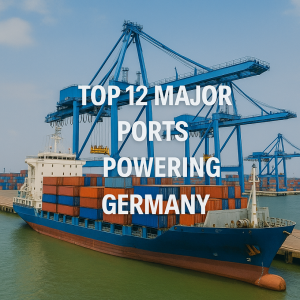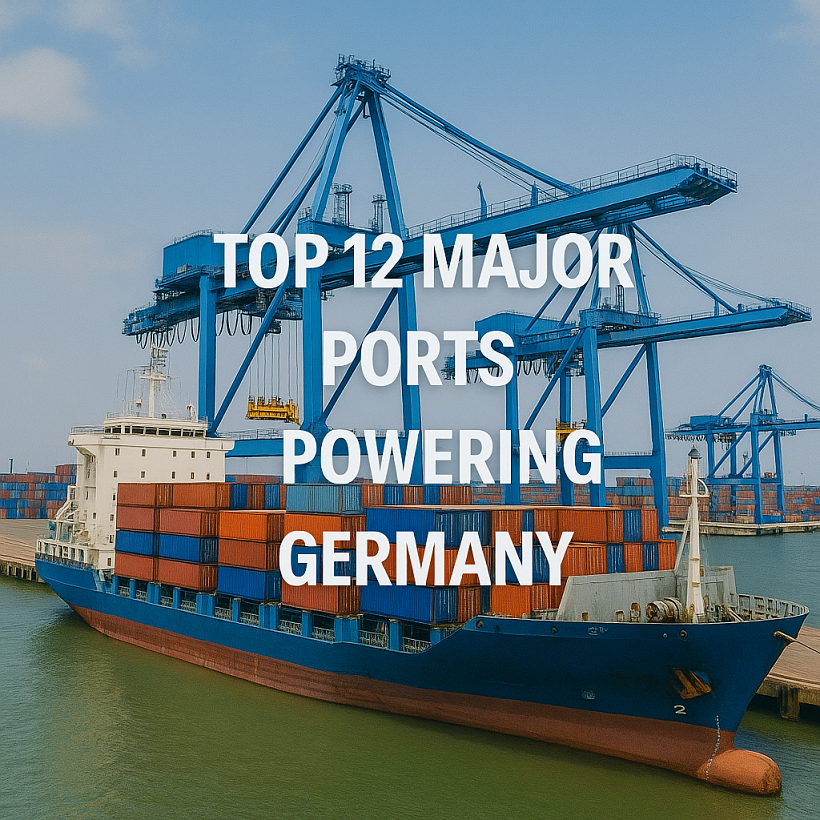
Discover the top 12 major ports in Germany, their strategic importance, cargo volumes, and future outlook. Learn how these gateways connect Europe to global trade in this comprehensive maritime guide.
Why German Ports Matter
Germany, Europe’s largest economy, relies heavily on its ports to sustain global trade and feed its industrial base. While Rotterdam and Antwerp dominate the continent’s container volumes, German ports provide unique strengths: inland connectivity, automobile exports, industrial raw material flows, and strong ties to Scandinavia, the Baltics, and China’s Belt and Road rail corridors.
Together, these ports form a diverse network—deep-water container hubs, Baltic RoRo gateways, inland logistics powerhouses, and industrial bulk terminals. Below we explore the 12 most important German ports, each with its own distinct role in the global maritime economy.
1. Port of Hamburg – Germany’s “Gateway to the World”
Nicknamed the “Gateway to the World”, the Port of Hamburg is Germany’s largest seaport and the third-busiest container hub in Europe, after Rotterdam and Antwerp.
-
Container Throughput: About 7.7 million TEUs in 2023 (Hamburg Port Authority).
-
Geography & Access: Located 110 km inland on the River Elbe, it connects directly to the North Sea and offers excellent hinterland connections via rail and road.
-
Logistics Strength: Over 2,300 freight trains run weekly to and from Hamburg, making it Europe’s largest rail port. It serves Central and Eastern Europe better than many competing ports.
-
Corporate Presence: Major global shipping companies—including Hapag-Lloyd, with its global headquarters in Hamburg—anchor the city’s maritime identity.
-
Innovation: Hamburg has embraced digitalisation and sustainability with its smartPORT logistics system, which integrates real-time cargo flows, environmental monitoring, and traffic management.
-
Cruise Sector: Also a major passenger hub, Hamburg welcomed over 1 million cruise passengers pre-pandemic, reinforcing its role as a multi-purpose port.
2. Port of Bremerhaven – Europe’s Auto Gateway
Part of the Bremen/Bremerhaven port complex, Bremerhaven is Europe’s largest automobile handling port and one of Germany’s container giants.
-
Auto Handling: Over 1.5 million vehicles annually, shipped worldwide by brands like BMW, Mercedes-Benz, and Volkswagen.
-
Container Volumes: Roughly 5 million TEUs per year, ranking it among Europe’s top five container ports.
-
Specialisation: Strong focus on RoRo traffic, container handling, and refrigerated cargoes.
-
Renewable Energy Role: Bremerhaven has become a logistics hub for the offshore wind industry, with facilities for turbine assembly, storage, and export.
-
Naval Importance: Home to Germany’s Federal Navy units and significant shipbuilding and repair infrastructure.
3. Port of Wilhelmshaven – Germany’s Deep-Water Hub
Wilhelmshaven is Germany’s only true deep-water port, with a naturally deep channel allowing access for the world’s largest container ships (20,000+ TEUs).
-
JadeWeserPort: The flagship container terminal, operational since 2012, can accommodate ultra-large vessels without tidal restrictions.
-
Container Volumes: Handles about 700,000 TEUs annually, but with growth potential as shipping alliances increasingly use mega-ships.
-
Energy Gateway: Hosts Germany’s first floating LNG terminal, built in response to the 2022 energy crisis, and serves as a strategic hub for crude oil and petroleum products.
-
Strategic Significance: Seen as a future energy and logistics hub, supporting Germany’s shift towards diversified energy imports and larger container ship operations.
4. Port of Lübeck – The Baltic’s RoRo Champion
Situated on the Baltic Sea coast, Lübeck is a leading RoRo and ferry port, with strong links to Scandinavia and the Baltic states.
-
RoRo Focus: Major traffic in trailers, trucks, and vehicles transported by ferry services to Sweden, Finland, and the Baltic region.
-
Forest Products: Europe’s largest hub for paper, timber, and pulp, crucial for northern Europe’s forest industries.
-
Geographic Advantage: Close to Hamburg, but uniquely positioned to serve Baltic short-sea trades.
-
Specialisation: Around 50% of Lübeck’s traffic consists of forest product imports, making it a vital hub for Germany’s publishing, packaging, and furniture industries.
5. Port of Rostock – Baltic Gateway of Eastern Germany
Rostock is the largest port in the former East Germany and remains a key Baltic maritime hub.
-
Ferry Links: Daily routes connect Rostock with Denmark, Sweden, and Finland, making it a strong ferry and RoRo hub.
-
Bulk Cargo: Handles coal, grain, fertilizers, and building materials.
-
Energy Role: Its Petrochemical Terminal is crucial for importing crude oil, which is transported inland through pipelines to refineries.
-
Industrial Integration: Close to Mecklenburg-Vorpommern’s industrial belt, Rostock serves regional agriculture, construction, and chemical sectors.
6. Port of Kiel – Passenger and Cruise Powerhouse
The Port of Kiel has a dual focus: passenger traffic and cargo throughput.
-
Ferry Services: Strong connections with Scandinavia and the Baltics, especially Sweden and Lithuania.
-
Cruise Hub: Pre-pandemic, Kiel welcomed over 2 million cruise passengers annually, rivaling Hamburg in northern Germany’s cruise market.
-
Cargo Role: Increasingly handling containers and bulk cargoes.
-
Kiel Canal Access: Located at the entrance of the Kiel Canal, the busiest man-made waterway in the world, with over 30,000 ships transiting annually. This location makes Kiel a strategic stopover point for global shipping.
7. Port of Emden – Volkswagen’s Maritime Stronghold
The Port of Emden, on the North Sea, is heavily tied to Germany’s automotive and renewable energy sectors.
-
Volkswagen Hub: Serves as the primary export terminal for Volkswagen vehicles, with millions shipped worldwide each year.
-
Wind Energy Logistics: Plays a critical role in handling offshore wind turbines, components, and installation vessels.
-
Diverse Cargo: Also handles forest products, paper, and steel, alongside heavy-lift and project cargoes.
8. Port of Cuxhaven – Fisheries and Offshore Hub
Cuxhaven, located at the mouth of the Elbe River, is a mid-sized but strategically significant port.
-
RoRo & Offshore Wind: Key player in offshore wind logistics, supporting turbine transport and installation.
-
Fishing Industry: Long-established base for Germany’s North Sea fishing fleet and fish processing.
-
Hamburg Alternative: Provides relief and alternative access to the congested Hamburg region.
9. Port of Duisburg (Duisport) – World’s Largest Inland Port
While not on the coast, Duisburg is indispensable in Germany’s maritime network.
-
Scale: The world’s largest inland port, located at the confluence of the Rhine and Ruhr rivers.
-
Connectivity: Direct barge and rail connections to Rotterdam, Antwerp, and Hamburg, serving Germany’s industrial heartland.
-
China Links: A major hub for China-Europe rail freight, with regular trains arriving from Chongqing, Wuhan, and Xi’an—making Duisburg a Belt and Road flagship in Europe.
-
Intermodal Hub: Its trimodal logistics system (water, rail, road) makes it a model for sustainable inland transport integration.
10. Port of Brunsbüttel – Kiel Canal Guardian
Located at the western entrance of the Kiel Canal, Brunsbüttel plays a key role in bulk and energy logistics.
-
Bulk & Chemicals: Handles liquid cargoes like chemicals, petroleum, and LNG, as well as dry bulk.
-
Canal Support: Supports the 30,000+ annual vessel transits through the Kiel Canal, providing bunkering, services, and storage.
-
Industrial Support: Connected to the regional chemical and energy clusters along the Elbe.
11. Port of Nordenham – Industrial Bulk Specialist
Nordenham, near Bremerhaven, has been a specialist bulk port for over a century.
-
Commodities: Handles coal, ore, bauxite, and other industrial raw materials.
-
Industrial Users: Supplies nearby aluminum smelters and heavy industries.
-
Legacy: Known as one of Germany’s oldest industrial ports, reflecting the country’s reliance on maritime imports for industrial growth.
12. Port of Wismar – Niche Baltic Hub
The Baltic port of Wismar is smaller in scale but plays a specialised role.
-
Primary Cargoes: Handles timber, paper, and building materials.
-
Renewables: Growing presence in handling offshore wind components and heavy-lift cargo.
-
Regional Role: Serves the construction and forest products industries of northern Germany.
–
Why German Ports Are Strategic to Europe
German ports are not just national gateways; they are European lifelines. Hamburg competes directly with Rotterdam and Antwerp, while Bremerhaven dominates in vehicle exports. Together, they anchor the TEN-T (Trans-European Transport Network) corridors, feeding goods to markets from Scandinavia to the Alps.
The European Commission’s transport data shows that around 65% of Germany’s exports and imports move through seaports. This illustrates how ports serve as critical arteries of Europe’s largest economy.
Challenges Facing German Ports
-
Competition from Neighboring Ports – Rotterdam and Antwerp attract volumes due to deeper drafts and efficiency.
-
Environmental Pressures – Compliance with IMO 2020 sulphur cap, EU Green Deal, and Germany’s energy transition.
-
Digital Transformation Needs – Some ports lag behind in adopting full smart-port technologies.
-
Climate Change Risks – Rising sea levels, extreme storms, and river droughts (affecting inland connectivity) challenge long-term planning.
Future Outlook
-
Green Ports: Hamburg, Wilhelmshaven, and Bremerhaven are investing in hydrogen, shore power, and carbon-neutral operations.
-
Offshore Energy Hubs: Emden, Cuxhaven, and Rostock will expand their role in wind energy logistics.
-
Digitalisation: Initiatives like Hamburg’s “smartPORT” will spread to other German ports.
-
Diversification: Smaller ports (Wismar, Lübeck) are repositioning to handle niche cargoes like renewables and forest products.
Case Study: Hamburg and the Belt and Road Initiative
In recent years, Hamburg has positioned itself as Europe’s main rail–sea interface for Chinese trade. With more than 200 weekly container train connections to China, it is not only a seaport but a logistics hub bridging continents.
This integration shows how ports are no longer just about ships, but about being part of global supply chain networks.
FAQ
1. What is Germany’s largest port?
The Port of Hamburg is Germany’s largest, handling about 7–8 million TEUs annually.
2. Which German port handles the most cars?
Bremerhaven is Europe’s leading car handling port, moving more than 1.5 million vehicles yearly.
3. What is Duisburg known for?
Duisburg is the world’s largest inland port and a major hub for China–Europe rail freight.
4. Are German ports environmentally sustainable?
Yes. Ports like Hamburg and Wilhelmshaven invest in shore power, hydrogen projects, and electrified logistics in line with the EU Green Deal.
5. How important are German ports for the EU?
They are critical, serving as gateways for Central and Eastern Europe, and forming part of TEN-T corridors.
Conclusion
The Top 12 major ports in Germany showcase the country’s maritime diversity—from Hamburg’s global container hub to Bremerhaven’s auto trade, Duisburg’s inland power, and Wilhelmshaven’s energy gateway. Together, they form the backbone of Europe’s logistics chain.
As global trade evolves, German ports face challenges in competition, climate change, and digitalisation. But with their strong industrial ties, green initiatives, and strategic geography, they are poised to remain central players in European and global shipping.
For maritime students, professionals, and enthusiasts, understanding German ports means understanding one of the most sophisticated and future-oriented port systems in the world.
References
-
Hamburg Port Authority. (2023). Port Statistics
-
UNCTAD. (2023). Review of Maritime Transport. Link
-
Bremenports. (2023). Bremerhaven Cargo Data
-
JadeWeserPort Wilhelmshaven. (2023). Official Site
-
German Seaport Association (ZDS). (2023). Facts & Figures
-
European Commission. (2022). TEN-T Core Network Corridors. Link
-
MarineTraffic. (2023). Live Vessel Movements
-
Lloyd’s List Intelligence. (2023). Port Performance Rankings.

